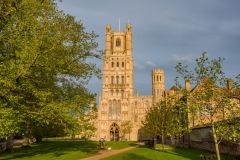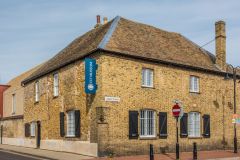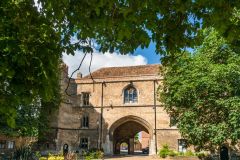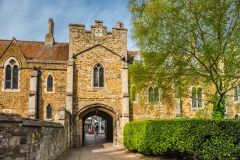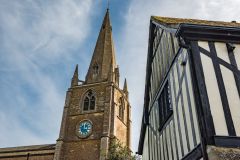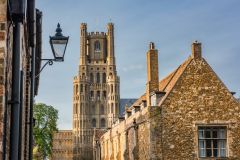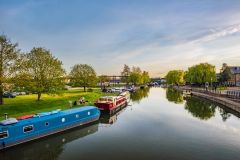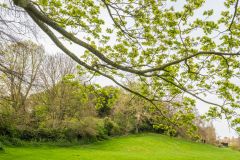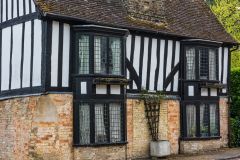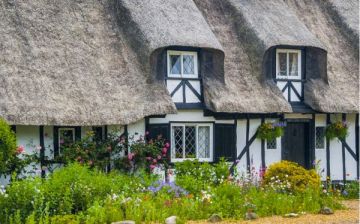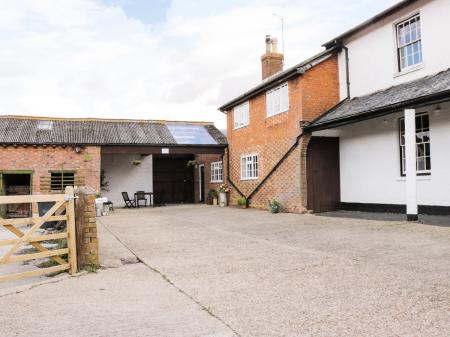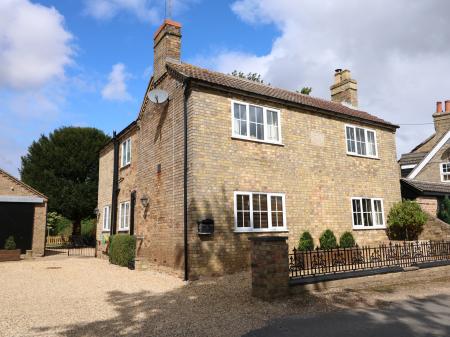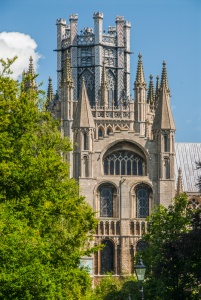
When a ceiling becomes a major tourist attraction, you know its a very remarkable ceiling indeed. At Ely, the ceiling in question certainly qualifies as remarkable. Ely Cathedral boasts one of the most amazing engineering feats of the Middle Ages in the form of its unique Octagon Tower.
There has been a church here since the 7th century, when St. Etheldreda, a Saxon queen, founded a cathedral on an island rising out of the surrounding marshes of the Fenland. Ely Cathedral was one of the premier Saxon churches in England, on a par with Glastonbury and Canterbury.
After the Norman invasion, Simeon, a kinsman of William the Conqueror, was named Abbot of Ely, and it was Simeon who began rebuilding the earlier Saxon cathedral in 1083, creating in the process one of the best examples of Romanesque architecture in England.
In the early 14th century, the Norman tower collapsed, and it is then that Alan of Walsingham steps into the limelight of history. He designed a central tower that seems to float unsupported above the crossing of Ely Cathedral like a cloud.
The "lantern tower" is actually formed by a series of massive oak beams which rise to a height of 63 feet. The tower is supported by diagonal oak beams resting upon stone pillars. These pillars support a total weight of some 400 tons of wood and lead. Most English cathedrals are built to a pattern of twin west towers flanking the main entrance and a central (crossing) tower. Ely has just one west tower and the huge Octagonal Tower.
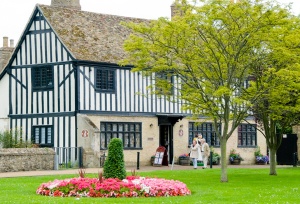
Ely Cathedral was one of the premier Saxon churches in England, on a par with Glastonbury and Canterbury.
Ely Cathedral is much more than just a tower. The Norman carvings at Ely are remarkable in themselves, particularly those decorating the Prior's Door, and the choir is resplendently rich in Gothic carvings, this time in wood.
As mentioned, Ely began life as an island, effectively isolated by the surrounding fens. Its name means Isle of Eels, for the eels which swam in the waters surrounding it. So abundant were the eels that they were used as currency in the past. Imagine paying your rent in eels!
It was the isolation of Ely which attracted the last great "English" hero to hold out against the Norman invaders. Hereward the Wake used Ely as his base during his bitter rebellion against William the Conqueror. The rebellion lasted several years against the superior Norman forces, before Hereward was finally defeated, or as some histories suggest, bribed to stop.
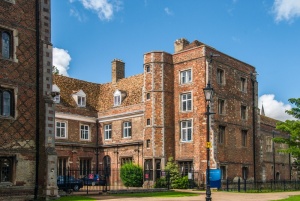
It was not until the Fens were drained in the 17th and 18th centuries that Ely's isolation ended. The cathedral still rises above the surrounding flat land like a beacon, calling to pilgrims.
There is more to Ely than the cathedral, however, though the cathedral is reason enough to visit. Several fine medieval buildings grace the city, notably the Bishop's Palace, King's School, and St. Michael's.
Oliver Cromwell once lived in Ely, and his 14th-century half-timbered house is now home to the local Tourist Information Centre.
Near Ely is another remarkable church, this time in ruins. Crowland Abbey was once the grandest abbey in the country. It was founded by King Ethelbald of Mercia in memory of his kinsman, St. Guthlac, who lived here as a hermit until his death in 714.
Ely is a peaceful small town, filled with beautiful Georgian buildings. And then there is that ceiling ....
About Ely
Address: Ely,
Cambridgeshire,
England
Attraction Type: Town
Location map
OS: TL537 803
Photo Credit: David Ross and Britain Express
POPULAR POSTS
HERITAGE
 We've 'tagged' this attraction information to help you find related historic attractions and learn more about major time periods mentioned.
We've 'tagged' this attraction information to help you find related historic attractions and learn more about major time periods mentioned.
Historic Time Periods:
Georgian
Medieval
Saxon
Victorian
Find other attractions tagged with:
14th century (Time Period) - 15th century (Time Period) - 7th century (Time Period) - Cromwell (Person) - Georgian (Time Period) - Gilbert Scott (Person) - Medieval (Time Period) - Norman (Architecture) - Oliver Cromwell (Person) - Restoration (Historical Reference) - Saxon (Time Period) - Victorian (Time Period) - William the Conqueror (Person) -
NEARBY HISTORIC ATTRACTIONS
Heritage Rated from 1- 5 (low to exceptional) on historic interest
Oliver Cromwell's House - 0.1 miles (Historic Building) ![]()
St Marys Church, Ely - 0.1 miles (Historic Church) ![]()
Ely Museum - 0.2 miles (Museum) ![]()
Stained Glass Museum - 0.2 miles (Museum) ![]()
Ely Cathedral - 0.2 miles (Cathedral) ![]()
Ely Bishop's Palace - 0.3 miles (Historic Building) ![]()
Wilburton, St Peter's Church - 4.9 miles (Historic Church) ![]()
Soham, St Andrew's Church - 5.5 miles (Historic Church) ![]()
Nearest Holiday Cottages to Ely:
Littleport, Cambridgeshire
Sleeps: 5
Stay from: £607 - 1825
